苏教版(凤凰)牛津英语教案4B U4第3课时
- 格式:doc
- 大小:35.00 KB
- 文档页数:3
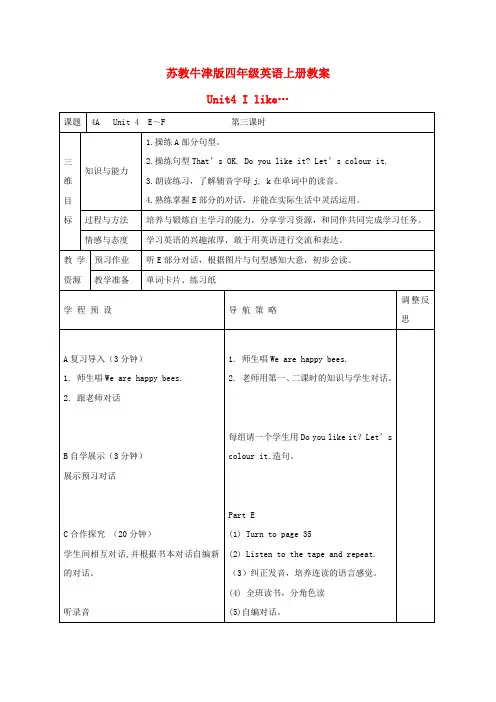
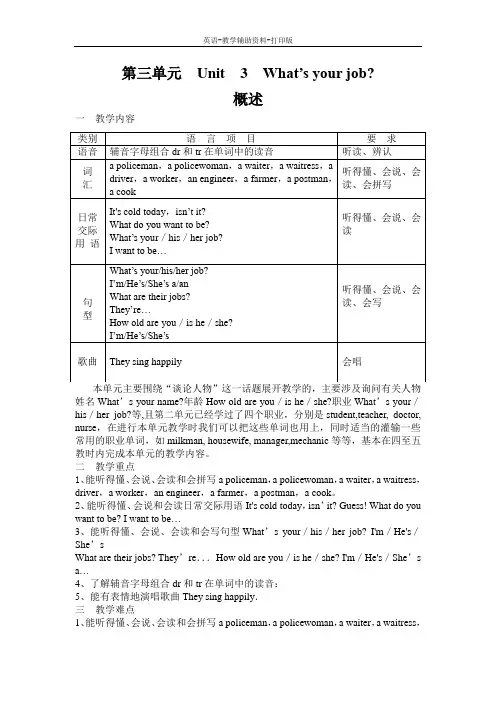
第三单元Unit 3 What’s your job?概述一教学内容姓名What’s your name?年龄How old are you/is he/she?职业What’s your/his/her job?等,且第二单元已经学过了四个职业,分别是student,teacher, doctor, nurse,在进行本单元教学时我们可以把这些单词也用上,同时适当的灌输一些常用的职业单词,如milkman, housewife, manager,mechanic等等,基本在四至五教时内完成本单元的教学内容。
二教学重点1、能听得懂、会说、会读和会拼写a policeman,a policewoman,a waiter,a waitress,driver,a worker,an engineer,a farmer,a postman,a cook。
2、能听得懂、会说和会读日常交际用语It's cold today,isn’it? Guess! What do you want to be? I want to be…3、能听得懂、会说、会读和会写句型What’s your/his/her job? I'm/He's/She’sWhat are their jobs? They’re...How old are you/is he/she? I'm/He's/She’s a…4、了解辅音字母组合dr和tr在单词中的读音:5、能有表情地演唱歌曲They sing happily.三教学难点1、能听得懂、会说、会读和会拼写a policeman,a policewoman,a waiter,a waitress,driver,a worker,an engineer,a farmer,a postman,a cook。
2、能听得懂、会说、会读和会写句型What’s your/his/her job? I'm/He's/She’sWhat are their jobs? They’re...How old are you/is he/she? I'm/He's/She’s a…3、句型以及日常交际用语It's cold today,isn’it? Guess! What do you want to be?I want to be…在实际生活中的灵活运用。
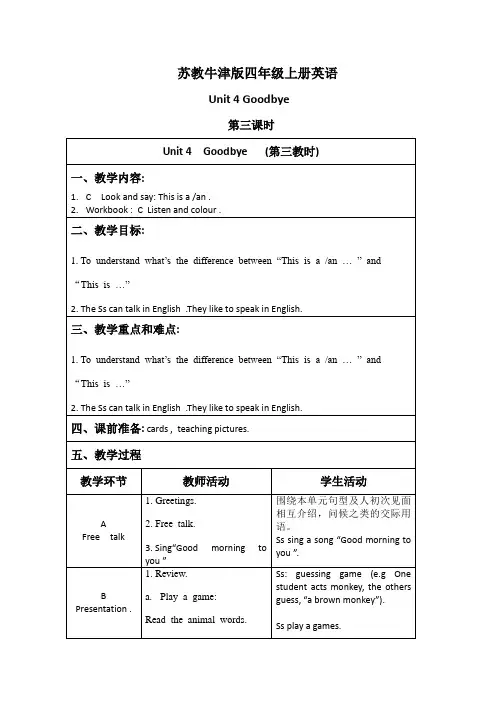
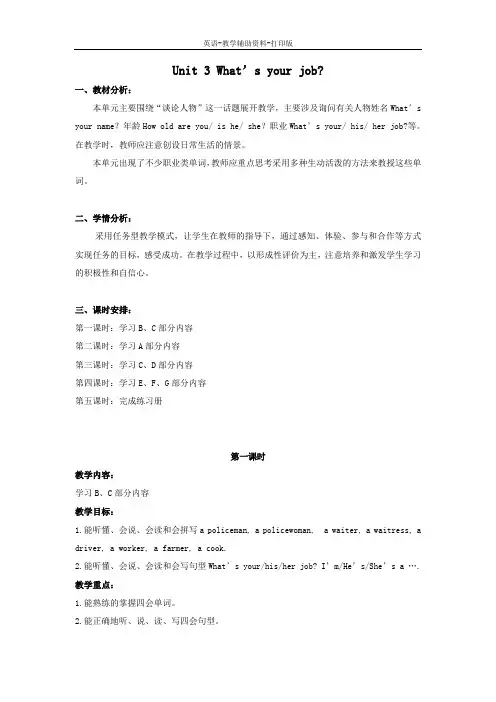
Unit 3 What’s your job?一、教材分析:本单元主要围绕“谈论人物”这一话题展开教学,主要涉及询问有关人物姓名What’s your name?年龄How old are you/ is he/ she?职业What’s your/ his/ her job?等。
在教学时,教师应注意创设日常生活的情景。
本单元出现了不少职业类单词,教师应重点思考采用多种生动活泼的方法来教授这些单词。
二、学情分析:采用任务型教学模式,让学生在教师的指导下,通过感知、体验、参与和合作等方式实现任务的目标,感受成功。
在教学过程中,以形成性评价为主,注意培养和激发学生学习的积极性和自信心。
三、课时安排:第一课时:学习B、C部分内容第二课时:学习A部分内容第三课时:学习C、D部分内容第四课时:学习E、F、G部分内容第五课时:完成练习册第一课时教学内容:学习B、C部分内容教学目标:1.能听懂、会说、会读和会拼写a policeman, a policewoman, a waiter, a waitress, a driver, a worker, a farmer, a cook.2.能听懂、会说、会读和会写句型What’s your/his/her job? I’m/He’s/She’s a…. 教学重点:1.能熟练的掌握四会单词。
2.能正确地听、说、读、写四会句型。
教学难点:能在句子中灵活运用单词。
教学疑点:学生能否搞清his和her的区别。
教学准备:图片、单词和句型卡片、录音机和磁带板书设计:Unit 3 What’s your job?A: What’s your/his/her job? a driver a cook a farmerB: I’m/He’s/She’s a …. a policeman a policewomana waiter a waitress a worker教后小记:第二课时教学内容:学习A部分内容教学目标:1.能听懂、会说、会读和会写句型:What’s your/his/her job? I’m/He’s/She’s a…. What are their jobs? They’re … . How old are you/ is he/she? I’m/He’s/She’sa ….2.能正确理解和掌握对话内容,并能朗读、表演对话。
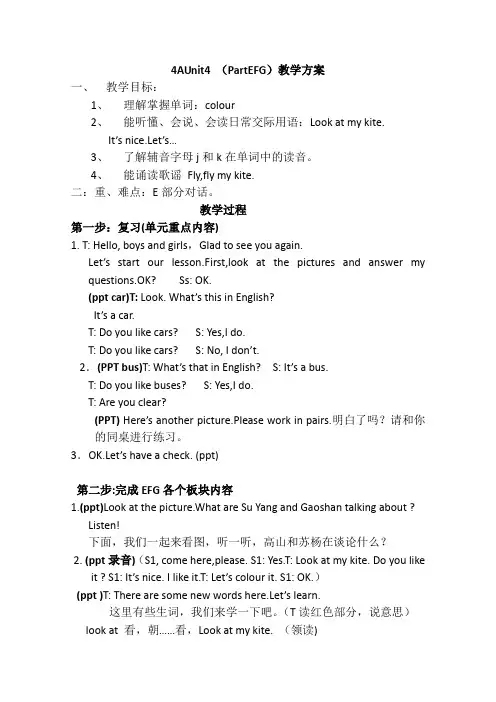
4AUnit4 (PartEFG)教学方案一、教学目标:1、理解掌握单词:colour2、能听懂、会说、会读日常交际用语:Look at my kite.It’s nice.Let’s…3、了解辅音字母j和k在单词中的读音。
4、能诵读歌谣Fly,fly my kite.二:重、难点:E部分对话。
教学过程第一步:复习(单元重点内容)1. T: Hello, boys and girls,Glad to see you again.Let’s start our lesson.First,look at the pictures and answer my questions.OK? Ss: OK.(ppt car)T:Look. What’s this in English?It’s a car.T: Do you like cars? S: Yes,I do.T: Do you like cars? S: No, I don’t.2.(PPT bus)T: What’s that in English? S: It’s a bus.T: Do you like buses? S: Yes,I do.T: Are you clear?(PPT)Here’s another picture.Please work in pairs.明白了吗?请和你的同桌进行练习。
3.OK.Let’s have a check. (ppt)第二步:完成EFG各个板块内容1.(ppt)Look at the picture.What are Su Yang and Gaoshan talking about ?Listen!下面,我们一起来看图,听一听,高山和苏杨在谈论什么?2. (ppt录音)(S1, come here,please. S1: Yes.T: Look at my kite. Do you likeit ? S1: It’s nice. I like it.T: Let’s colour it. S1: OK.)(ppt )T: There are some new words here.Let’s learn.这里有些生词,我们来学一下吧。
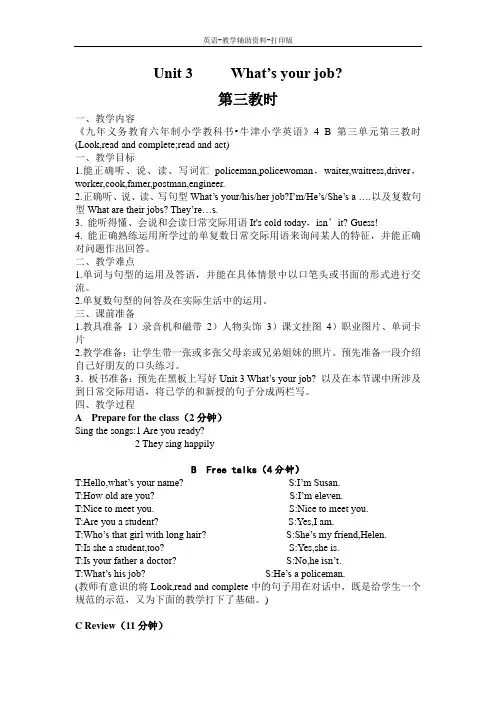
U nit 3 What’s your job?第三教时一、教学内容《九年义务教育六年制小学教科书•牛津小学英语》4 B第三单元第三教时(Look,read and complete;read and act)一、教学目标1.能正确听、说、读、写词汇policeman,policewoman,waiter,waitress,driver,worker,cook,famer,postman,engineer.2.正确听、说、读、写句型What’s your/his/her job?I’m/He’s/She’s a ….以及复数句型What are their jobs? They’re…s.3. 能听得懂、会说和会读日常交际用语It's cold today,isn’it? Guess!4. 能正确熟练运用所学过的单复数日常交际用语来询问某人的特征,并能正确对问题作出回答。
二、教学难点1.单词与句型的运用及答语,并能在具体情景中以口笔头或书面的形式进行交流。
2.单复数句型的问答及在实际生活中的运用。
三、课前准备1.教具准备1)录音机和磁带2)人物头饰3)课文挂图4)职业图片、单词卡片2.教学准备:让学生带一张或多张父母亲或兄弟姐妹的照片。
预先准备一段介绍自己好朋友的口头练习。
3.板书准备:预先在黑板上写好Unit 3 What’s your job? 以及在本节课中所涉及到日常交际用语,将已学的和新授的句子分成两栏写。
四、教学过程A Prepare for the class(2分钟)Sing the songs:1 Are you ready?2 They sing happilyB Free talks(4分钟)T:Hello,what’s your name?S:I’m Susan.T:How old are you? S:I’m eleven.T:Nice to meet you. S:Nice to meet you.T:Are you a student? S:Yes,I am.T:Who’s that girl with long hair? S:She’s my friend,Helen.T:Is she a student,too? S:Yes,she is.T:Is your father a doctor? S:No,he isn’t.T:What’s his job? S:He’s a policeman.(教师有意识的将Look,read and complete中的句子用在对话中,既是给学生一个规范的示范,又为下面的教学打下了基础。
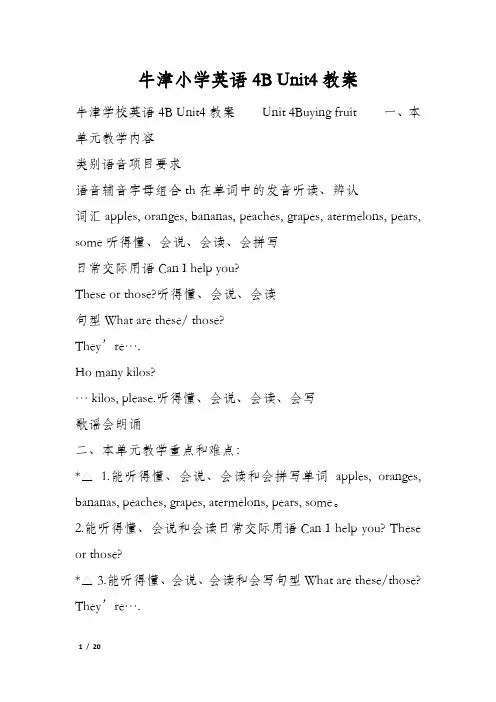
牛津小学英语4B Unit4教案牛津学校英语4B Unit4教案Unit 4Buying fruit 一、本单元教学内容类别语音项目要求语音辅音字母组合th在单词中的发音听读、辨认词汇apples, oranges, bananas, peaches, grapes, atermelons, pears, some听得懂、会说、会读、会拼写日常交际用语Can I help you?These or those?听得懂、会说、会读句型What are these/ those?They’re….Ho many kilos?… kilos, please.听得懂、会说、会读、会写歌谣会朗诵二、本单元教学重点和难点:*△ 1.能听得懂、会说、会读和会拼写单词apples, oranges, bananas, peaches, grapes, atermelons, pears, some。
2.能听得懂、会说和会读日常交际用语Can I help you? These or those?*△ 3.能听得懂、会说、会读和会写句型What are these/those? They’re….Ho many kilos? … kilos, please.*△ 4.初步把握名词复数的词形和读音的变化。
5.了解辅音字母组合th在单词中的两种不同读音。
6.能有表情地流利的诵读歌谣《I like fruit》。
(p.s.*为教学难点,△ 为教学重点。
)三、教材内容分析:本单元的核心教学内容是“认物”,主要学习句子What are these/ those? They’re…。
Book4A中已经消失What’s this/ that? It’s…句型。
教学中老师可以采纳应用以旧带新的方法,从单数句式引出复数句式,还可以通过单复数形式比较找出它们之间的区分。
本单元主要消失了水果类单词,除lemons, straberries, grapes 三种水果是第一次消失以外,其余八种均在Book3A第三单元中消失过。
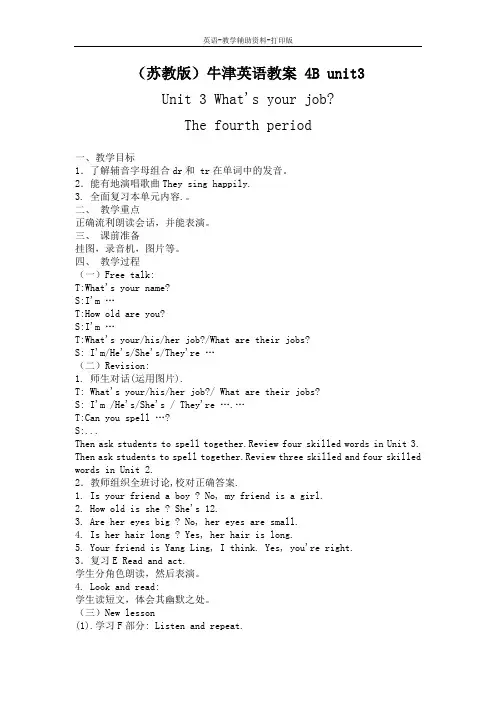
(苏教版)牛津英语教案 4B unit3Unit 3 What's your job?The fourth period一、教学目标1.了解辅音字母组合dr和 tr在单词中的发音。
2.能有地演唱歌曲They sing happily.3. 全面复习本单元内容.。
二、教学重点正确流利朗读会话,并能表演。
三、课前准备挂图,录音机,图片等。
四、教学过程(一)Free talk:T:What's your name?S:I'm …T:How old are you?S:I'm …T:What's your/his/her job?/What are their jobs?S: I'm/He's/She's/They're …(二)Revision:1. 师生对话(运用图片).T: What's your/his/her job?/ What are their jobs?S: I'm /He's/She's / They're ….…T:Can you spell …?S:...Then ask students to spell together.Review four skilled words in Unit 3. Then ask students to spell together.Review three skilled and four skilled words in Unit 2.2.教师组织全班讨论,校对正确答案.1. Is your friend a boy ? No, my friend is a girl.2. How old is she ? She's 12.3. Are her eyes big ? No, her eyes are small.4. Is her hair long ? Yes, her hair is long.5. Your friend is Yang Ling, I think. Yes, you're right.3.复习E Read and act.学生分角色朗读,然后表演。
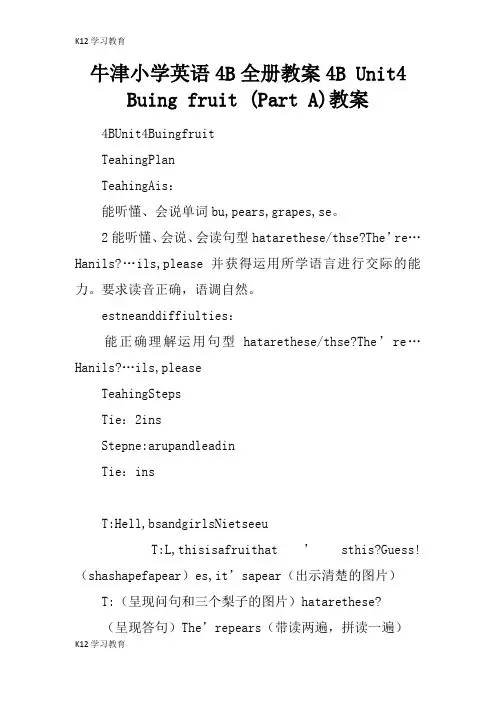
牛津小学英语4B全册教案4B Unit4 Buing fruit (Part A)教案4BUnit4BuingfruitTeahingPlanTeahingAis:能听懂、会说单词bu,pears,grapes,se。
2能听懂、会说、会读句型hatarethese/thse?The’re…Hanils?…ils,please并获得运用所学语言进行交际的能力。
要求读音正确,语调自然。
estneanddiffiulties:能正确理解运用句型hatarethese/thse?The’re…Hanils?…ils,pleaseTeahingStepsTie:2insStepne:arupandleadinTie:insT:Hell,bsandgirlsNietseeuT:L,thisisafruithat’sthis?Guess!(shashapefapear)es,it’sapear(出示清楚的图片)T:(呈现问句和三个梨子的图片)hatarethese?(呈现答句)The’repears(带读两遍,拼读一遍)2T:刚才有一个梨子,用什么句子提问的呢?hat’sthis?近处有三个梨子,又是怎么提问的呢?出示hatarethese?(呈现句子,带读两遍,学生看老师口型)在这里,these是“这些”的意思。
所以,当我们想知道近处有一些什么东西的时候,我们可以这样问:hatarethese?回答用的是The’re它们是(呈现句型,带读两遍)3T:Bsandgirls,lthere(shagrape)hat’sthat?It’sagrape(出示单词卡,带读两遍,拼读一遍)(shabunhfgrapes)N,agrape?esrn?N,the’regrapes (出示句子,带读单词两遍,句子一遍)因为那儿不止一颗葡萄,我们该怎么提问呢?hatarethse?(呈现问句,带读两遍)当我们想知道远处有一些什么东西时,就可以用这个句子进行提问,回答时,依然可以说:The’re4T:现在跟老师一起来复习一下我们刚才学习的两组句型。
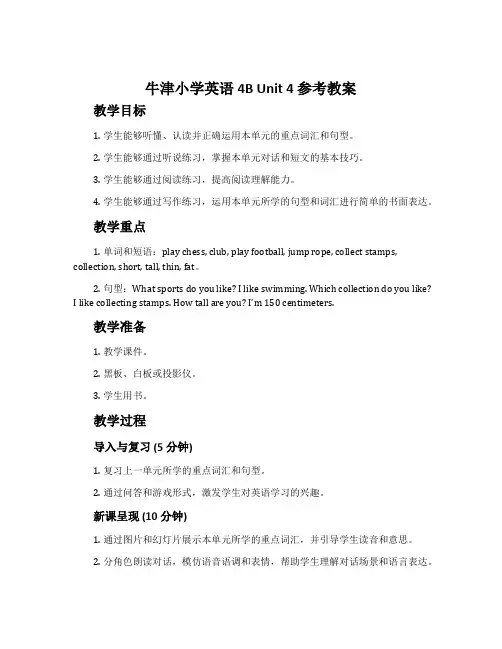
牛津小学英语4B Unit 4 参考教案教学目标1.学生能够听懂、认读并正确运用本单元的重点词汇和句型。
2.学生能够通过听说练习,掌握本单元对话和短文的基本技巧。
3.学生能够通过阅读练习,提高阅读理解能力。
4.学生能够通过写作练习,运用本单元所学的句型和词汇进行简单的书面表达。
教学重点1.单词和短语:play chess, club, play football, jump rope, collect stamps, collection, short, tall, thin, fat。
2.句型:What sports do you like? I like swimming. Which collection do you like?I like collecting stamps. How tall are you? I’m 150 centimeters.教学准备1.教学课件。
2.黑板、白板或投影仪。
3.学生用书。
教学过程导入与复习 (5分钟)1.复习上一单元所学的重点词汇和句型。
2.通过问答和游戏形式,激发学生对英语学习的兴趣。
新课呈现 (10分钟)1.通过图片和幻灯片展示本单元所学的重点词汇,并引导学生读音和意思。
2.分角色朗读对话,模仿语音语调和表情,帮助学生理解对话场景和语言表达。
听力训练 (15分钟)1.听录音,学生按照录音内容判断图片与录音是否相符。
2.听录音,学生根据听到的信息回答问题或完成练习册上的题目。
口语练习 (20分钟)1.学生分组进行问答练习,模仿对话表达自己的喜好。
2.学生根据展示的图片进行对话练习,使用所学句型和词汇进行交流。
阅读训练 (15分钟)1.学生阅读课本上的文章,回答问题并进行分组讨论。
2.学生阅读练习册上的阅读理解题目,完成相应的任务。
书面表达 (15分钟)1.学生根据提示写一篇短文,介绍自己的喜好和特点,使用本单元所学的句型和词汇。
2.学生交换作文并进行互评,给予建议和提供改进意见。
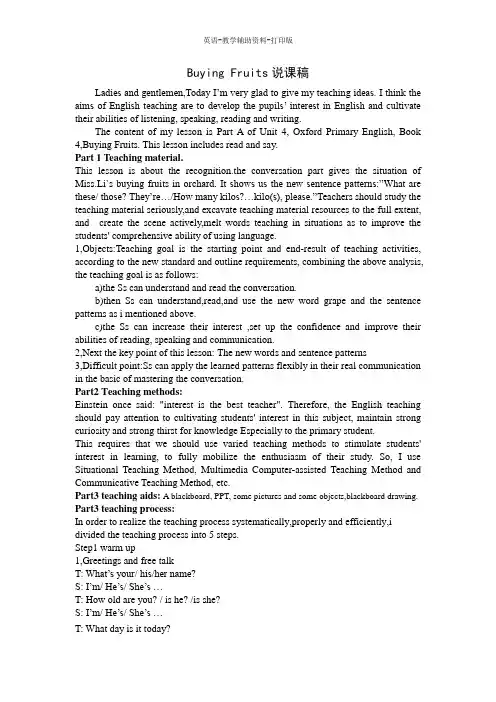
Buying Fruits说课稿Ladies and gentlemen,Today I’m very glad to give my teaching ideas. I think the aims of English teaching are to develop the pupils’ interest in English and cultivate their abilities of listening, speaking, reading and writing.The content of my lesson is Part A of Unit 4, Oxford Primary English, Book 4,Buying Fruits. This lesson includes read and say.Part 1 Teaching material.This lesson is about the recognition.the conversation part gives the situation of Miss.Li`s buying fruits in orc hard. It shows us the new sentence patterns:”What are these/ those? They’re…/How many kilos?…kilo(s), please.”Teachers should study the teaching material seriously,and excavate teaching material resources to the full extent, and create the scene actively,melt words teaching in situations as to improve the students' comprehensive ability of using language.1,Objects:Teaching goal is the starting point and end-result of teaching activities, according to the new standard and outline requirements, combining the above analysis, the teaching goal is as follows:a)the Ss can understand and read the conversation.b)then Ss can understand,read,and use the new word grape and the sentence patterns as i mentioned above.c)the Ss can increase their interest ,set up the confidence and improve their abilities of reading, speaking and communication.2,Next the key point of this lesson: The new words and sentence patterns3,Difficult point:Ss can apply the learned patterns flexibly in their real communication in the basic of mastering the conversation.Part2 Teaching methods:Einstein once said: "interest is the best teacher". Therefore, the English teaching should pay attention to cultivating students' interest in this subject, maintain strong curiosity and strong thirst for knowledge Especially to the primary student.This requires that we should use varied teaching methods to stimulate students' interest in learning, to fully mobilize the enthusiasm of their study. So, I use Situational Teaching Method, Multimedia Computer-assisted Teaching Method and Communicative Teaching Method, etc.Part3 teaching aids:A blackboard, PPT, some pictures and some objects,blackboard drawing. Part3 teaching process:In order to realize the teaching process systematically,properly and efficiently,i divided the teaching process into 5 steps.Step1 warm up1,Greetings and free talkT: What’s your/ his/her name?S: I’m/ He’s/ She’s …T: How old are you? / is he? /is she?S: I’m/ He’s/ She’s …T: What day is it today?S: It’s …T: Wh at’s the weather like today?S:It’s …The greetings take the Ss into the atmosphere of learning English and concentrate their attention on the class.2,afterwards i will show some pictures of fruits on the PPT(apples pears oranges),then i will ask the Ss: what are they? Which fruit do you like? (write down the word “fruit”on the blackboard.)I lead the fruits out and then show the first two sentences.Step 2 presentation and practice1,I will take out some fruits which were covered by a cloth.T:since you are all like fruits, let`s go to the fruit shop, guess,what is that?(what are these?)S1:it`s.../they are...(S2,S3...)then i will show the fruits on the blackboard.T:what is that?(what are those?)S1:it`s.../they are...(S2,S3...)Let’s chant:These, these, what are these?Apples, apples, they are apples.Those, those, what are those?Grapes, grapes, they are grapes.(Boys read the former parts and girls the later parts.)Chant trips off the tongue mobilizes the classroom atmosphere, and consolidate the new sentence patterns,the boy and girl students read in consociation exercise their cooperation ability. )2,T:what would you like?Ss:i like apples.T: i like apples too, i`d like some apples,how many would you like?(write down the sentence patterns)Ss:one/two/three(S1,S2...)Say a chant:How many, how many, how many kilos?One kilo, two kilos, three kilos;Four kilos, five kilos, six kilos;Seven kilos, eight kilos, nine kilos;I’d like nine kilosSupposed that we are in the shop, the Ss will be wanted to play a role game. Situational Teaching Method stimulate the students' interest in learning and cultivate their English communication skills,and oral communication ability3,let`s open the book,look!who is she?what is she doing now?the Ss answer she is Miss Li,she is buying fruits,i will repeat: Miss Li is buying fruits, let`s go with her.OK?listen to the tape and answer the question(taped on the PPT)What fruit does Miss Li buy? They are some_grapes_and _pears_. I will ask the Ss to draw the answeras a picture on blackboard.then read the conversation after me,then answer me:how many kilos of pear/grape would Miss.Li like?Read it in roles. (Boys act as the farmer and girls act as Miss Li.)Read the dialogue in roles with your partners.Step 3 productionHelen is your friend,she is ill,you are going to visit her with some fruits,act it out. It can help the T and Ss to know how the Ss master the contest and how the Ss apply it to real situation.Step4 assignmentSummarize the whole lesson,and arrange the homework.Do the correlative exercises in the activity book.Step5 blackboard designShow on the CAI.(It’s a ….)Anyway, the teaching of this lesson aims to develop not only the Ss' language technical abilities, but also the diverse intelligence by integrated teaching methods.As teachers, to make our English classrooms shine with vitality, we are laid with heavy burden, and we still have long way to go.Above is the lecture notes of my lesson. Thank you!。
牛津 4B Unit 4 Buying fruit teaching plan一、单元教课目的:1、四会单词buy, apples, oranges, bananas, peaches, grapes, pears, some these, those, how many,kilo; 三会单词 pineapples, watermelons b5E2RGbCAP2 、四会句型 What are these/those? They ’reHow many kilos? kilos, please. p1EanqFDPw3 、三会句型 Can I help you? These or those?4 、会朗读歌谣 I like fruit.5 、能听读、辨识辅音字母 th 在单词中的发音。
二、They 本单元的中心教课内容是“认物”和“购物”,主要学习句子’re及联合常用语Can I help you? What are these/those? TheyWhat are these/those?’re How many kilos?kilos, please. These or those? 等进行购置水果的活动。
本单元出现了八个水果类的单词,除grapes是第一次出现外,其余单词均在Book 3A 第三单元中出现过。
本单元出现的是这些单词的复数形式,波及到词形、读音的变化,是教课中的难点。
DXDiTa9E3dUnit 4 Buying fruit (第一课时)一、教课内容:B Look, read and learnC Ask and answer C Look and say RTCrpUDGiT二、教课目的:1、能听、说、读、写单词buy, apples, oranges, bananas, peaches, grapes, pears, some these,those, how many, kilo 5PCzVD7HxA2 、能听、说、读单词pineapples, watermelons3 、能听、说、读、写句型What are these/those? They ’re How many kilos? kilos, please. jLBHrnAILg4 、能听、说、读句型Can I help you? These or those?三、教课要点:1、四会单词buy, apples, oranges, bananas, peaches, grapes, pears, some these, those, how many,kilo; 三会单词pineapples, watermelons xHAQX74J0X2 、四会句型What are these/those? They’re How many kilos?kilos, please.四、教课难点:1 、四会句型What are these/those? They’re How many kilos?kilos, please. LDAYtRyKfE Zzz6ZB2Ltk2 、能正确朗诵水果类的单词并掌握其复数形式的词形和读音。
(苏教版)牛津英语教案四年级下册unit4Unit 4 Buying fruitThe third periodTeaching aims and difficulties:1.熟练掌握“四会”单词apples, oranges, bananas, peaches, grapes, watermelons, pears。
2.能听得懂、会说和会读日常交际用语These or those?3.能结合实际情景正确运用Can I help you? I’d like some…These or those?How many kilos? …kilos, please. 等句型。
Teaching procedures:Step 1. Warming-up and revisions1. Review the chant .2. Review how to say the kilos and price.T: How much a kilo? ( Take out the card: 5元/Kg)S: Five yuan a kilo.T: How much two kilos?S: Ten yuan two kilos.T: How much a pound? ( Take out the card: 2.5元/p)S: Two yuan five jiao a pound.T: How much four pounds?S: Ten yuan four pounds.T: (More practise.)Step 2. PresentationT: Some students told me they haven’t bought fruits last class. So let’s give them a chance to continue. XXX, come here, please.T: Can I help you?S1: I’d like some strawberries for my grandmother.T: OK. How many kilos?S1: One kilo, please.T: OK, here you are.S1: How much are they?T: Eight yuan five jiao.S1: OK, here you are.T: Thank you. Goodbye!S1: Bye-bye!T-S S-SStep 3. New structures learning1. How about…? Here’s the money.T: OK, all of us have bought things in the classroom now. I’m very happy. Oh, I forgot one important thing, I haven’t bought thin gs for you, my students. I must buy something for you. Who can be the shop assistant now?S: I try.T: OK, you please.S1: Can I help you?T: I’d like to buy some sugar canes for my students. How much a kilo?S1: Six yuan a kilo.T: En, how about five yuan a kilo?S1: OK. How many kilos?T: Let me see. Five kilos, please.S1: Here you are.T: How much are they?S1: Twenty-five yuan, please.T: Here’s the money.S1: Thank you. Goodbye!T: See you!T-S2. These or those? The … ones, please.T: I have bought some sugar canes for my students, they’re so heavy. I still want to buy some pineapples and strawberries for my students. Who can buy them for me?S: I try.T: OK, you please.T: ( Act as the shop assistant.) Can I help you?S2: I’d like to buy some pinea pples for my teacher.T: These or those?( Point to the pineapples.)S2:The big ones. How much a kilo?T: The big ones are ten yuan a kilo.S2: Five kilos, please.T: OK, here you are. Fifty yuan, please.S2: Here’s the money.T: Thank you. Goodbye!S2: Bye!S-TStep 4. PracticeT: Thank you. You’ve done a good job. Now, class, I’ve opened a company. The customers can book all kinds of fruits in it. I have to buy the fruits for them now. Oh, the telephone is ringing. I have to answer the telephone. Who can buy the fruits on the cards for me now.S: I try.T: OK, this card is for you. …( Give the cards to some students.)Card 1: apples 3元/Kg 2 kilosCard 2: pears 2.5元/Kg 4 kilosCard 3: Strawberries 4元/Kg 1 kiloS-SStep 5. ConsolidationS: Hand in the fruits to me.T: Thank you very much. The fruits are for you. That’s all for this lesson.HomeworkOral work: Read and practise Unit 4 Written work: Copy the new words and drills.。
Unit 4 Buying fruit一、教材分析:本单元的核心教学内容是“认物”,主要学习句子What are these/those? They’re…. Book 4A中已经出现What’s this/ that? It’s ┅.句型。
教学中教师可以采用以旧带新的方法,从单数句式引出复数句式,还可以通过单复数形式比较找出他们之间的区别。
本单元出现了八个水果类单词,除grapes这个水果单词是第一次出现以外,其余七种水果均在三年级出现过。
本单元出现的是这些单词的复数形式,涉及到词形、读音的变化,是教学中的难点。
教师可以对名词复数的词形和读音进行归类。
与本单元所出现的水果类单词紧密结合的是在商店里购物的常用语Can I help you? How many kilos? These or those?等。
在教学中教师要注意创设购物情景,让学生熟练自如地运用这些购物的基本用语。
二、学情分析:让学生在老师的指导下,在学习的过程中进行情感和策略的调整,以形成积极的学习态度,促进语言实际运用那里的提高。
三、课时安排:第一课时:学习B、C部分内容第二课时:学习A、D部分内容第三课时:学习E、F、G部分内容第四课时:完成练习册第一课时教学内容:学习B、C部分内容教学目标:1.能听懂、会说、会读和会拼写单词apples, oranges, bananas, peaches, grapes, pears, watermelons, pineapples。
2.能听懂、会说、会读和会拼写句型What are these/ those? They’re …教学重点:1.能熟练的掌握四会单词。
2.能正确地听、说、读、写四会句型。
教学难点:能在句子中灵活运用单词。
教学疑点:学生能否搞清单数和复数的区别。
教学准备:图片、单词和句型卡片、实物水果板书设计:Unit4 Buying fruitA:What are these/ those? apples oranges bananas peachesB: They’re …. grapes pears watermelons pineapples教后小记:第二课时教学内容:学习A、D部分内容教学目标:1.能听懂、会说、会读和会拼写句型What are these/ those? They’re …. How many kilos? ┅ kilos, please.2.能听得懂、会说和会读日常交际用语I’d like some ┅, please. Here you are.教学重点:1.能听懂、会说、会读和会拼写句型What are these/ those? They’re …. How many kilos? ┅ kilos, please.2.能听得懂、会说和会读日常交际用语I’d like some ┅, please. Here you are.教学难点:能有表情地朗读并表演Read and say。
苏教版(凤凰)牛津英语教案2011
4B Unit4 (Part EFG) 教学方案
年级:4年级单元:Unit 4
课题:Buying fruit 课型:新授课
教学目标: 1. 进一步复习巩固水果类单词和主要句型。
2. 能听懂、会说、会读日常交际用语Can I help you? These or
those? 并获得运用所学语言进行交际的能力。
3. 了解辅音字母组合th在单词中的两种不同读音。
4. 能有表情地诵读歌谣I like fruit.
重点难点:句型Can I help you? These or those?的理解实际运用。
教学过程
用时:25分钟
第一步:复习(单元重点内容)
用时:3分钟
T: (PPT 1 显示课题)Hello, boys and girls. Glad to see you.
T: 在第四单元中,我们已经学习了八种水果和提问“一些物品”的句型,你还记得吗?现在我们一起来复习复习吧!(PPT2呈现单词和句型,带读)
T: Look, here’s a bag. There’re some fruit in it. 瞧,老师的袋子里装了些水果,(拿出水果)They’re apples.
T: Now, another bag here is. 大家想知道这里面是什么水果吗?Please touch and guess. 你可以来摸一摸,猜一猜。
Let the girl try. 先让她来试一试吧。
(师生示范)
T: 刚才老师让她猜袋子里的水果,问的是:(PPT3在老师讲解完后分别呈现句子)What are these? 她猜的时候用Are they ... ? 第一次,她没猜对,我说:No. 第二次她猜对了,我告诉她:Yes.
T: 你们会玩这个游戏了吗?拿出你们带来的水果做游戏吧。
(停2秒)
第二步:完成各版块教学
用时:15分钟
T: 和水果做完了游戏,我们再来看个小故事吧。
Now let’s watch a cartoon.你能记住动画中的句子吗,为动画配音吗?(PP4播放G1动画)
T: What a naughty monkey!这只小猴子真调皮!其实它就藏在我们的英语书上。
Open your books at page 36. Please read in pairs.
T: 好!现在我们来试着给动画故事配音吧!(再次播放动画,静音)
T: 看完了这个小故事,我们再来看看这两位女士在做什么。
(PPT5播放E部分动画)What’s she doing? Yes, she’s buying fruit, too. 她又是怎样买的呢?Now, look at your books, page 35. Read in pairs, please. 同桌分角色读一读,找找这段对话中有哪些与A部分不同的购物用语。
T:售货员是怎么招呼顾客的呢?她说的是:Can I help you? 我能为你效劳吗?(PPT6点击呈现句子)这是服务人员常用的招呼语,当然,在你想帮助他人的时候也可以使用。
因为这儿有红苹果和青苹果两种,所以售货员又详细询问顾客要哪一种。
She says ‘These or those?’这些还是那些?
T: Now, listen and repeat.现在请大家跟读一遍。
(PPT7完整呈现对话,点击播放句子读音)
T: OK. Please try to act this dialogue in pairs. One will be the custom, one will be the saleswoman. 请你和同桌分角色表演这一小段对话。
先请这两位同学给大家做个示范吧。
(学生示范)
T: Have a try, please. 大家开始表演吧。
T: I think all the fruit are very good. So I like fruit. Does Mimi like them? 我喜欢水果,Mimi也喜欢吗?Let’s go and see. (PPT8播放歌谣动画)
T: Mimi likes fruit, too. She says ‘I like fruit’. (PPT9呈现歌谣题目)Mimi喜欢苹果,她说(PPT9呈现歌谣第一段)Apples, apples, red and sweet. I like to eat. 苹果又红又甜。
Sweet, sweet, “甜”的意思。
Mimi还喜欢香蕉和梨,她说(PPT9呈现歌谣第二段)Bananas and pears, green and yellow. 香蕉和梨也很好吃,但是要等到明天再吃。
Eat them tomorrow.(带读句子一遍,单词tomorrow一遍,再读句子一遍)
T: OK. Let’s read again. (看老师口型,读一遍)
T: 下面我们来练习语音。
(PPT10呈现单词图片)Look at the picture. What are those over there?(PPT10点击呈现句子)Three thin dogs. (PPT10点击呈现句子)字母组合th在单词中的发音有两种,请跟我读,并且思考该怎么读。
(带读What are those over there? Three thin dogs.)在问句中有两个词those和there,其中th的发音是/ /。
而答句中three和thin这两个词中th的发音是/ /。
T: 下面我们来总结一下字母组合th的发音,一种是/ /,把舌尖放在两齿之间,不出声音,(PPT11呈现单词)three, thin, think。
另一种是/ /,口型一样,这次要发出声音,(PPT11呈现单词)there, those, they。
T: 同学们,学会了吗?试试读一读下面的句子。
(PPT11呈现句子)
T: 再请大家读一读这些单词(PPT12呈现单词),注意th的发音。
(带读单词一遍)
(结束语)
T: 在第四单元中,我们一起学习了水果类单词,以及如何询问“一些物品”是什么的句型,还学会了怎样购买水果。
相信你在今后的学习生活中能很好的运用所学到的知识进行交流。
Goodbye, boys and girls!。